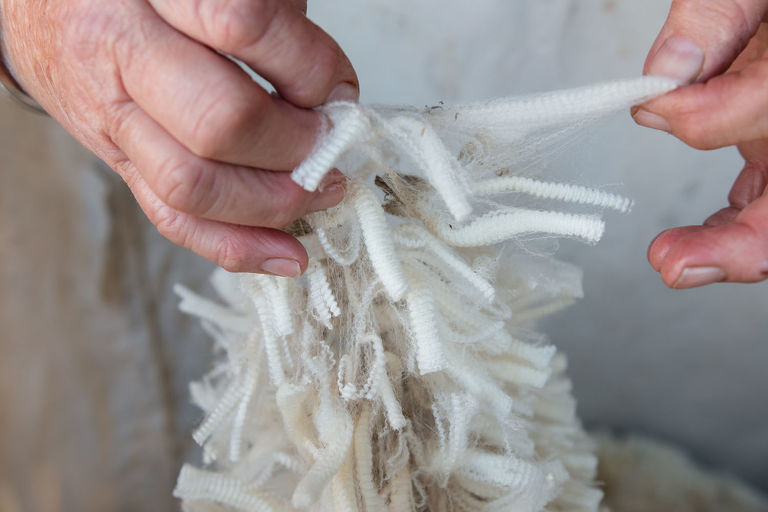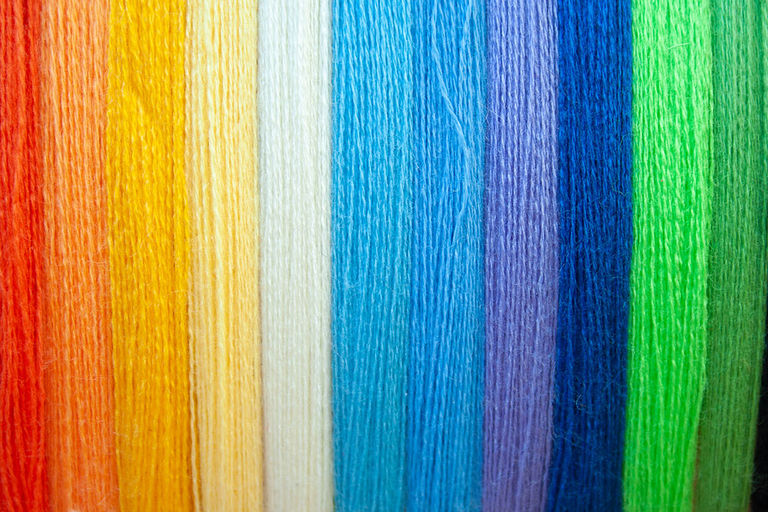Carpet Construction
Welcome to our guide to the fibres and twists we use in the construction of our carpets. You can understand why we use the fibres we do and the different construction methods and nuances of twisting techniques influence a carpet's durability, feel, and aesthetic appeal. Unravel the artistry beneath your feet!
Natural and Man Made Fibres
Solution Dyed Nylon Type 6
Solution Dyed Nylon Carpet (SDN) is a very popular flooring choice as a result of its built-in resilience and affordability.
Pros:
- Colour Fastness:
Solution-dyed nylon is highly resistant to fading and discolouration caused by UV rays. The colour is embedded within the fibre itself, making it more durable than surface-dyed options.
- Stain Resistance:
Because the colour is an inherit part of the fibres, solution-dyed nylon carpets are also highly resistant to staining. Spills bead up on top of the fibre rather than the carpet absorbing the spill into the fibre, which provides more time for clean up.
- Durability:
Nylon fibres are known for their strength and resilience. Solution-dyed nylon maintains these characteristics, making it suitable for high-traffic areas and applications that require longevity. Even lighter-weight (lower budget) carpets have optimal performance and are very popular choices.
- Easy Maintenance:
Due to its stain and soil resistance, solution-dyed nylon is often easier to clean and maintain than other carpets. Regular vacuuming and occasional cleaning are sufficient to keep it looking good.
- Environmentally friendly:
Type 6 Solution dyed Nylon is more environmentally friendly than other synthetic fibres and even wool! Due to its molecular structure type 6 Nylon is able to be regenerated and not just recycled meaning it can become carpet or other textiles an infinite amount of times. See Econyl Regeneration for more details
Cons:
- Initial Cost:
Solution-dyed nylon products can be more expensive upfront compared to other synthetic materials. However, the increased durability and longevity will offset this initial cost over time.
- Static Electricity: *
Nylon fibres can generate static electricity, leading to unpleasant shocks and attracting dust and debris. Anti-static treatments are often applied to mitigate this issue.
*side note** (Carpet Mills premium solution dyed nylon products have a carbon filament embedded into the fibre which negates any static charge) .
Type 6 Solution dyed nylon is the best fibre for Carpet.

New Zealand Wool
Pros:
- Insulation:
Wool has excellent insulating properties. It helps regulate indoor temperature by retaining heat in cold weather and keeping spaces cooler in warmer weather, potentially leading to energy savings.
- Sound Absorption:
Wool's dense and plush nature makes it effective at absorbing sound, reducing noise levels and creating a quieter environment.
- Hypoallergenic:
Wool fibres tend to trap dust, pollen, and other allergens, preventing them from becoming airborne. This can be beneficial for individuals with allergies.
- Flame Retardant:
Wool has inherent flame-resistant properties, as it requires higher temperatures to ignite compared to many synthetic materials.
Cons:
- Cost:
Wool carpet is generally more expensive than synthetic alternatives due to the cost of producing and processing natural wool fibres.
- Prone to Shedding:
Being a natural fibre there will be some fibre loss within the carpet known as shedding
- Stains and Spills:
Due to its absorbing ability, woollen carpets are more likely to stain compared to synthetic carpets
- Colour Fading:
Wool is susceptible to colour fading over time, especially in areas exposed to direct sunlight.
- Moisture Sensitivity:
Wool can absorb moisture and take time to dry. This can lead to mould and mildew growth if the carpet is consistently exposed to damp conditions.
- Pilling:
Woollen loop pile carpets in high-traffic areas can develop small, fuzzy balls of fibre called pills.
- Carpet Beetle:
Woollen carpet is susceptible to carpet beetle which feeds on the protein of the wool and deteriorates the carpet eventually leaving it threadbare
Wool is the second-best fibre for Carpets

Polyester
Polyester is a low-cost synthetic and ideal for those prioritising a luxurious feel over extended durability. With a shorter life span compared to Nylon and wool, it is well suited for low-traffic areas like a study, guest room or summer batch
Pros:
- Affordability:
Polyester carpet is generally a more budget-friendly option
- Stain Resistance:
Polyester fibres are naturally resistant to many stains. They have a hydrophobic nature that makes them less likely to absorb spills and liquids.
- Fade Resistance:
Polyester is often treated with UV-resistant solutions, making it more resistant to fading and discolouration caused by sunlight exposure than wool.
- Quick Drying:
Polyester doesn't absorb moisture as readily as some other materials, so spills are less likely to lead to lingering odours or mould growth.
Cons:
- Durability:
While advancements have been made in polyester's durability, it still generally isn't as durable as some other carpet materials, such as nylon. It can wear down more quickly in high-traffic areas.
- Matting and Crushing:
Polyester fibres can be prone to matting and crushing, especially in areas with heavy foot traffic. This can result in a flattened worn appearance over time.
- Static Electricity:
Polyester fibres can generate static electricity, leading to shocks and attracting dust and debris. Some treatments can help prevent this issue.
- Environmental Impact:
Polyester is made from petroleum-based materials, it can be recycled in certain applications but will generally be downgraded to an inferior application and will not recover all of the material.
- Vulnerability to Fading:
Despite UV-resistant treatments, polyester carpets might still experience fading over time, particularly in areas with significant sunlight exposure.
We do not recommend Polyester carpets

Polypropylene
Pros:
- Affordability:
Polypropylene carpet is one of the most budget-friendly options among synthetic and natural fibre carpets. It provides a cost-effective solution for covering large areas.
- Stain Resistance:
Polypropylene is naturally resistant to many stains, including those from food and beverages. It has a low absorbency rate, which makes cleaning up spills easier.
- Moisture Resistance:
Polypropylene is inherently moisture-resistant, making it less likely to absorb water-based spills or moisture. This property can help prevent mould and mildew growth.
- Fade Resistance:
Polypropylene is often treated to resist fading from exposure to sunlight and UV rays. This makes it suitable for areas with lots of natural light.
- Easy Maintenance:
The stain and moisture resistance of polypropylene carpets make them relatively easy to clean and maintain. Regular vacuuming and occasional cleaning are often sufficient.
- Indoor and Outdoor
Use: needle punch carpet or garage carpet as it is generally referred to, is suitable for indoor and outdoor use. Due to its resistance to moisture and fading, polypropylene is often used in outdoor or semi-outdoor settings, such as garages, patios, decks, and porches.
Cons:
- Durability:
While polypropylene is relatively durable, it is not as resilient as nylon. It will show signs of wear and tear in high-traffic areas over time.
- Matting and Crushing:
Polyester fibres can be prone to matting and crushing, especially in areas with heavy foot traffic. This can result in a flattened worn appearance over time.
- Heat Sensitivity:
Polypropylene is sensitive to heat.
- Static Electricity:
Like other synthetic materials, polypropylene can generate static electricity, resulting in shocks and the attraction of dust and debris.
- Environmental Impact:
Polypropylene is made from petroleum-based materials, it can be recycled in certain applications but will generally be downgraded to an inferior application and will not recover all of the material.
We do not recommend Polypropylene carpets

Twists and loops
2 Ply Hard Twist Cut Pile
Constructed by taking 2 pieces of yarn (or piles) and tightly twisting them together, this method creates the most durable carpet with a textured look and reduced tracking & shading, ideal for those high-traffic areas.

Loop Pile
Loop pile carpets are crafted when the yarn is woven into small loops, which are left uncut. These loops create a dense and durable surface and also eliminate any shading and tracking. The smaller the loop the less flattening and 'wear' appearance.





















